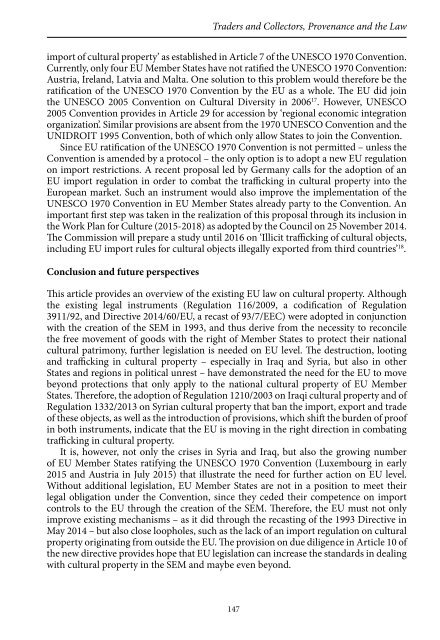Countering
Book_observatory_illicit_traffic_version%20issuu
Book_observatory_illicit_traffic_version%20issuu
You also want an ePaper? Increase the reach of your titles
YUMPU automatically turns print PDFs into web optimized ePapers that Google loves.
Robert Peters<br />
The path to fighting against the traffick in cultural property should not be difficult.<br />
In fact, a simple equation is sufficient: illegally exported cultural property from one<br />
State should be considered as illegally imported into another State. This simple equation<br />
should be the basis for future legislation, be it on national, EU or international level.<br />
Notes and References<br />
1. See ex Article 151 of the EC Treaty (TEC).<br />
2. See ex Article 28 and 29 TEC.<br />
3. See ex Article 30 TEC.<br />
4. There are six official languages of the UN: Arabic, Chinese, English, French, Russian<br />
and Spanish. All 24 EU Member State languages are official languages.<br />
5. UNESCO Convention on the Means of Prohibiting and Preventing the Illicit Import,<br />
Export and Transfer of Ownership of Cultural Property (Paris, adopted 14 November<br />
1970, entering into force 24 April 1972), 823 UNTS 231.<br />
6. As of September 2015, 129 States Parties (by acceptance, ratification, or notification of<br />
succession). See current status of States Parties. URL: < http://www.unesco.org/eri/la/<br />
convention.asp?KO=13039&language=E > [accessed 2 September 2015].<br />
7. Council Regulation (EEC) No. 3911/92 of 9 December 1992 on the Export of Cultural<br />
Goods, OJ L 395/1, 31 December 1992.<br />
8. Regulation (EC) No. 116/2009 of 12 December 2008 on the Export of Cultural Goods,<br />
OJ L 39, 10 February 2009.<br />
9. The legal basis for the enactment of regulations is Article 288 TFEU (ex Article<br />
249 TEC).<br />
10. Report from the Commission to the European Parliament, the Council and<br />
the European Economic and Social Committee on the implantation of Council<br />
Regulation (EC) No. 116/2009 of 18 December 2008 on the export of cultural goods<br />
(1 January 2011 - 31 December 2013) of 1 April 2015 (COM(2015) 144 final, Annex<br />
1).<br />
11. See Report (footnote 12), Annex 5.<br />
12. Directive 93/7/EEC on the Return of Cultural Objects Unlawfully Removed from the<br />
Territory of a Member State, 15 March 1993 OJ L74/74, 27 March 1993.<br />
13. Directive 2014/60/EU on the Return of Cultural Objects Unlawfully Removed from<br />
the Territory of a Member State of 15 May 2014, OJ L 159/1, 28 May 2014. Member<br />
States have 18 months to transpose the new provisions of the Directive into national<br />
law (until 19 December 2015).<br />
14. UNIDROIT Convention on Stolen or Illegally Exported Cultural Objects (Rome,<br />
adopted 24 June 1995, entering into force 1 July 1998, 34 ILM 1322.<br />
15. Council Regulation (EC) No. 1210/2003 of 7 July 2003 concerning certain specific<br />
restrictions on economic and financial relations with Iraq and repealing Regulation<br />
(EC) No 2465/96, OJ L 169 of 8 July 2003.<br />
16. Council Regulation (EU) No. 1332/2013 of 13 December 2013 amending Regulation<br />
(EU) No 36/2012 concerning restrictive measures in view of the situation in Syria,<br />
OJ L 335/3 of 14 December 2013.<br />
17. Convention on the Protection and Promotion of the Diversity of Cultural Expressions<br />
of 20 October 2005.<br />
18. Conclusions of the Council and of the Representatives of the Governments of the<br />
Member States, meeting within the Council on a Work Plan for Culture 2015-2018,<br />
148


